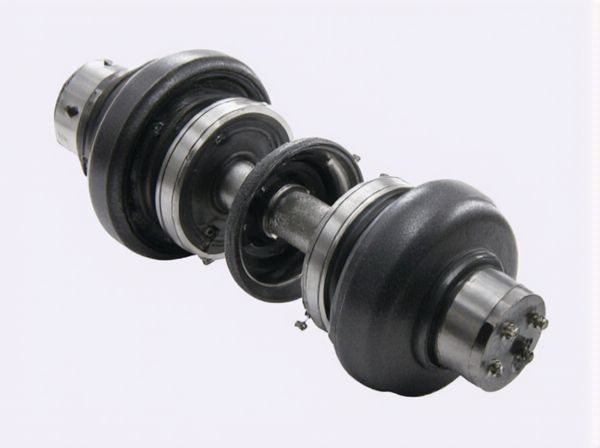
Photo illustration: Tandem Axle vs Single Axle
A tandem axle trailer offers increased stability and better weight distribution compared to a single axle, making it ideal for hauling heavy loads. Your choice depends on the load capacity, with tandem axles providing greater durability and smoother towing over long distances. Single axle trailers are easier to maneuver and maintain, suitable for lighter loads and shorter trips.
Table of Comparison
| Feature | Tandem Axle | Single Axle |
|---|---|---|
| Load Capacity | Higher load capacity, supports heavier weights | Lower load capacity, suitable for lighter loads |
| Stability | Improved stability, better weight distribution | Less stable, prone to sway under heavy loads |
| Cost | Higher initial and maintenance cost | Lower purchase and maintenance cost |
| Fuel Efficiency | Reduced fuel efficiency due to additional axle | Better fuel efficiency with less rolling resistance |
| Maneuverability | Less maneuverable in tight spaces | More maneuverable, easier to handle |
| Usage | Ideal for heavy-duty trucks, trailers | Best for light-duty vehicles and trailers |
Introduction to Axle Configurations
Tandem axle configurations feature two axles spaced closely together, providing enhanced load distribution and improved stability for heavy-duty trailers or trucks. Single axle setups utilize one axle, offering lighter weight and easier maneuverability, making them ideal for smaller trailers and lighter loads. Understanding the distinction between tandem and single axle systems is crucial for selecting the appropriate vehicle based on weight capacity, towing needs, and terrain conditions.
What is a Single Axle?
A single axle features one set of wheels mounted on a single shaft supporting the trailer or vehicle. It offers easier maneuverability and lower initial cost but provides less stability and weight capacity compared to tandem axle setups. Single axles are ideal for lighter loads and shorter trips where simplicity and cost-efficiency are prioritized.
What is a Tandem Axle?
A tandem axle consists of two axles placed close together on a trailer or vehicle, enhancing load distribution and stability compared to a single axle. It significantly increases weight capacity, making it ideal for heavy-duty applications such as commercial trailers and large RVs. The tandem axle design improves traction, reduces tire wear, and provides better handling on uneven or rough terrains.
Key Differences Between Tandem and Single Axle
Tandem axles consist of two sets of wheels spaced apart, providing better weight distribution and increased load capacity compared to a single axle's one set of wheels. Tandem axle trailers offer enhanced stability and smoother towing over rough terrain, reducing wear on tires and suspension. Single axle trailers, being lighter and more maneuverable, are typically more cost-effective and easier to maintain but have lower payload limits and less stability at higher speeds.
Load Capacity: Tandem vs Single Axle
Tandem axle trailers offer significantly higher load capacity compared to single axle trailers, often supporting weights ranging from 7,000 to 20,000 pounds or more depending on the configuration. Single axle trailers typically have a load capacity between 1,000 and 3,500 pounds, making them suitable for lighter loads. The increased load capacity of tandem axles enhances stability and weight distribution, which is crucial for heavy-duty hauling.
Maneuverability and Handling
Tandem axle trailers provide enhanced stability and smoother handling, especially on uneven terrain, by distributing weight more evenly across two axles. Single axle trailers offer superior maneuverability and easier turning in tight spaces due to their lighter weight and shorter wheelbase. Choosing between tandem and single axles depends on the balance between desired handling precision and load stability needs.
Maintenance and Durability Comparison
Tandem axle trailers offer enhanced durability and load distribution, reducing wear on individual tires and suspension components compared to single axle trailers. Maintenance costs for tandem axles can be higher due to the increased number of tires, brakes, and suspension parts requiring regular inspection and upkeep. However, the improved stability and balanced weight distribution of tandem axles often lead to longer lifespan and fewer issues with axle and frame fatigue.
Cost Implications: Purchase and Upkeep
Tandem axle trailers typically have higher upfront purchase costs due to the extra axle and enhanced load capacity compared to single axle trailers. Maintenance expenses on tandem axles also tend to be greater, with increased tire replacements, brake servicing, and suspension upkeep required over time. However, tandem axles often provide better stability and weight distribution, potentially reducing repair costs related to frame damage and improving overall long-term investment value.
Best Applications for Each Axle Type
Tandem axles provide enhanced stability and load distribution, making them ideal for heavy-duty applications such as commercial trailers, construction equipment, and long-haul transportation. Single axles are better suited for lighter loads and smaller trailers, often used in recreational vehicles, small utility trailers, and landscaping equipment. Selecting the appropriate axle type improves vehicle handling, load capacity, and overall safety for specific hauling needs.
Conclusion: Choosing the Right Axle for Your Needs
Selecting the appropriate axle depends on load capacity, trailer stability, and maneuverability requirements. Tandem axles provide better weight distribution, increased towing stability, and higher load capacity, making them ideal for heavy-duty applications. Single axles offer greater agility and simpler maintenance, suited for lighter loads and short-distance towing.
 caratoz.com
caratoz.com